Strategy July 24, 2015
Screen-Printing Class In Session
Many college screen-printing programs train the next generation of workers and spark a love for the craft
Many college screen-printing programs train the next generation of workers and spark a love for the craft.
As the spring semester draws to a close, students in the beginning screen-printing class at Central Piedmont Community College are busy finishing up their final assignment: printing a two-color design on a dark fabric using underbase. Christina Clark, sunglasses propped atop her shoulder-length brown hair and a blue apron covering her pink T-shirt, pulls her screens from the exposure unit, careful to avoid her classmates in the tight space. An aspiring DJ studying graphic arts and imaging at the Charlotte, NC school, the 27-year-old is printing a design she hopes to use as the label for the electronic dance music she mixes in her spare time.
“It exposed really well,” says Clark, examining the screens, holding them by the frame in her gloved hands. A circle containing two triangles and the words “Lil Saint Tina” in the center is almost visible on the bright green surface. “It’s never done that before.”
Clark lugs her two screens to the washout booth and starts spraying emulsion off the exposed screen. Over the loud hiss of the power washer, she shares her thoughts on screen printing. “It’s kind of cool because it’s like an art form,” she says. “You have to make sure you do it all right because in two seconds you can screw it up and have to start all over again.”
Instructor Zach Blackburn is there to help his students avoid such mistakes whenever possible, roaming between the computer lab and the press room to double-check their work and occasionally lend a hand with setup. The important thing, though, is for the students to get a feel for the process themselves. “It’s hard for me to tell them exactly how much pressure and speed to use on a squeegee stroke,” Blackburn says. “You’ve just got to do it.”
That hands-on philosophy is common to most colleges that offer screen-printing programs. For Central Piedmont and other institutions, it’s important to offer practical training that will serve students well in the job market. Gareth Burns, chairman of Central Piedmont’s graphic arts department, says his department put together an advisory committee of working professionals to help them craft their program. “We strive to teach based on what the industry needs,” he adds. Those needs include molding the next generation of screen-printing gurus.
The Learning Curve
Across the country, at Palomar College in San Marcos, CA, the aim is similar. The school offers three textile screen-printing courses, according to instructor Ken Dodson. In the introductory class, students get an overview of the process: creating artwork on the computer; stretching, reclaiming and coating screens; and printing several projects, ranging from single-color line art to a more complex two-color print.
“It’s like an art form. You have to make sure you do it all right because in two seconds you can screw it up and have to start all over again.”
Christina Clark, Central Piedmont Community College
In the advanced class, students learn how to handle process and spot-process jobs. Most of the students work with plastisol inks, but they also do some discharge work – which is encouraging to Dodson, who has been fighting an uphill battle to turn his students onto the benefits of waterbase inks. (Most of his students don’t like waterbase because they think it’s too hard to work with.)
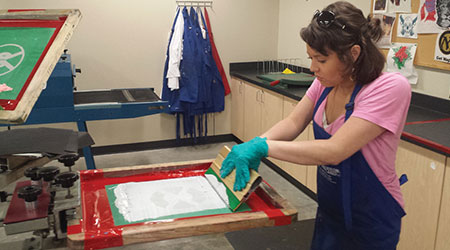
Christina Clark spreads a layer of silver ink over her fabric. Clark is working on her Lil Saint Tina design, which she hopes to use as the label for her DJ work.
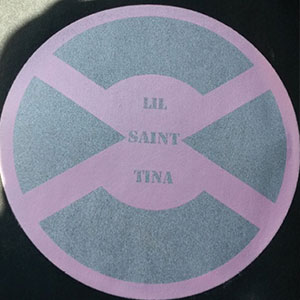
The third class, Dodson says, is structured more like a business, with students encouraged to seek out actual screen-printing jobs from other departments on campus. “It’s a little difficult because while we were given permission to do it and generate income for the department, we can only do it on campus, and there are only a handful of people that can use T-shirts,” Dodson says.
Though the business-oriented class has been a struggle to pull off, Palomar’s focus on practical skills is an overall success. “Most screen-printing shops around here want somebody that has at least a little bit of a background,” Dodson says. At Palomar and Central Piedmont, students can earn either a certificate in screen printing or an associate’s degree in graphic arts. Faculty from both institutions says their students have gone on to work in the industry, with many either starting their own apparel lines or opening screen-printing shops.
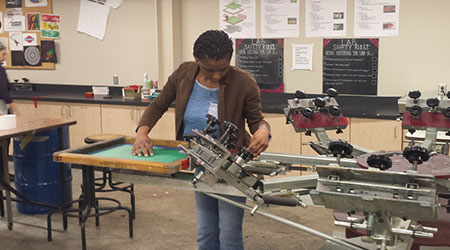
Teka Bradley sets up the press as she finishes up her final project in Central Piedmont’s screen-printing class.
Those success stories underscore the fine line that schools must walk for students who catch the printing bug. Allowing plenty of time for hands-on learning is an important part of any well-structured screen-printing class, but instructors say there are limits. Students at Central Piedmont are permitted in the lab only during class or other scheduled lab times. “We used to be very loosey-goosey about letting them use the labs,” Burns says. But the school prefers to have someone experienced on-hand to ensure the pricey equipment is being used properly.
Though Central Piedmont’s screen-printing lab contains all the elements of a working commercial shop, there’s one key difference: It’s not set up to handle volume work. That’s intentional, Blackburn says. Students are allowed to create and print artwork based on their interests and needs, but they’re not allowed to use the school’s equipment to launch their business. “Occasionally, we’d have a situation where students want to sell their work,” Blackburn adds. “That’s a no-no.”
Palomar College has found itself in a similar situation. Ken Block, one of the founders of DC Shoes, started his skateboarding apparel brand back in the 1990s as a student at Palomar, according to Dodson. “What he would do was just create art night after night at school, then come in and print and print and print,” Dodson explains. Block would give his shirts to skateboarders in the neighborhood, local skate shops would ask them where they’d gotten the clothing, and soon enough, the shops were calling Block and asking for garments, he adds.
“Most screen-printing shops around here want somebody that has at least a little bit of a background.”
Ken Dodson, Palomar College
Dodson calls the origin story Palomar’s “claim to fame,” but allowing students that kind of unlimited access to “a very robust shop with a lot of nice equipment” became a “slippery slope.” Eventually, the college instituted scheduled lab hours each semester with a lab tech and had to limit students to working on class projects only.
Printing Is Printing
Textile design students at Philadelphia University see a different side of screen printing. Instructor Nami Yamamoto has her students create a cohesive collection of women’s clothing, making repeat patterns on textiles, using a flat screen-printing table. The students are used to designing, but for the most part, Yamamoto’s class is the first time they see their designs on fabric. “That part is very exciting for them,” she says. Yamamoto leads her students through progressively more challenging projects, ending the class by requiring them to use a T-square to create a four-way repeat pattern using two or three colors.
Though few of her design students are likely to be using the screen-printing process Yamamoto teaches once they’re in the real world, it’s still important to understand the mechanics behind their designs, she says. “It’s a good skill for them to have,” she adds. “They’re not going to be printing in a production house, but as a designer, they will have to know the process.”
Printmaking is a staple in art department curriculums at colleges across the country, but the focus is not necessarily on résumé building. Zachary Fry learned that the hard way after graduating with a degree in printmaking from the University of North Carolina Pembroke. “I can tell you everything you want to know about etching and intaglio,” Fry says. “It’s not really a marketable job skill.”
Fry is now working on earning a screen-printing certificate from Central Piedmont to give himself a grounding in practical trade skills. The physical act of printing gives him little trouble, since printing is printing, whether it involves wood blocks or screens, he says. But before starting at Central Piedmont, Fry says he didn’t know much about the digital side of printing, and has been learning how to use art programs to create color separations.
An Involved Process
Though Millennials have a reputation for being tech-savvy digital natives, young screen-printing students often struggle to make the transition from the computer screen to the press, particularly when it comes to setting up print-ready artwork. “It’s hard to get students to understand until they start seeing how colors on the computer screen don’t necessarily represent what you’re going to get on the print end,” Dodson says. “That’s probably the most confusing thing for them.”
Burns of Central Piedmont says it’s important for students to learn a methodical, step-by-step procedure to ensure their artwork will come out properly. “It’s not always the sexiest of information, but we have to spell it out for them,” he adds.
Back in Blackburn’s beginning screen-printing class, Clark is learning the importance of proper art setup the hard way. Her screens are ready to be loaded onto one of the school’s two manual presses. “I’m scared of doing this because it’s the hardest part,” she admits, as she starts to line up the vellum and screen.
She’s optimistic, though. “Today is going perfect,” she says, then sighs. “You can ask anyone. I’ve been through hell trying to get this design perfect this semester.”
Clark starts to fiddle with the knobs on the finicky press for a few minutes before calling Blackburn over for help. He guides her through adjusting the up-down and side-to-side knobs, slowly bringing the screen into registration. “Twist toward me. … Keep going, keep going,” he says. When the image seems to be aligned, he has Clark press her palms against the screen, bringing it into contact with the vellum. “Now that’s pretty close,” he says.
A pleased Clark pops open the small ink-spattered buckets at her hip and begins dropping fat dollops of ink onto her screen. First, she spreads an underbase of silver over her design; next comes light pink. It isn’t until she’s finished squeegeeing the pink ink that she realizes she made a mistake when she prepared her artwork on the computer. Rather than using underbase for the foundation of the entire design, Clark added the silver ink only to the clear parts of her design – without underbase, the pink portions of the artwork fade into the black of the test fabric. Just like that, Clark’s print is ruined, and she heads back to her computer to start the process all over again – determined, this time, to get everything perfect, from start to finish.
Print Profiles
Students in Central Piedmont Community College’s beginner’s screen-printing class say they’ve enjoyed creating designs that reflect their personal interests. Here is a sampling of their work.

Amber Dobbins, 20, started out studying graphic design at Central Piedmont, but she was miserable until she switched over to the graphic arts and imaging program. “This is more hands-on and more physical,” she says. “Not everything is about your ‘design aesthetic.’” Dobbins likes to infuse her quirky sense of humor into her prints, like this toilet being beamed up by UFO’s glow-in-the-dark tractor beam. “It’s a little silly, I know, but it makes me happy,” she says.
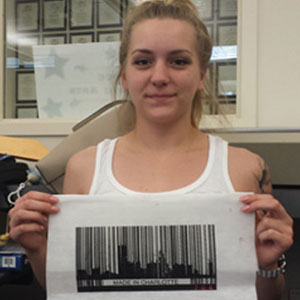
Caroline Wilcox, 19, says she’s always enjoyed drawing, and entered Central Piedmont’s graphic design program on a scholarship. Her “Made in Charlotte” print merges a barcode with the Charlotte skyline. Wilcox says she’s fallen in love with screen printing: “I love getting my hands dirty, the ink, all of it.”
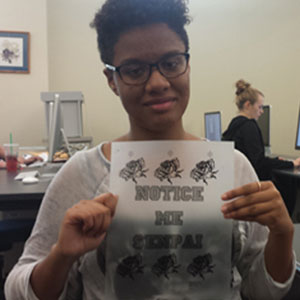
Mariah Cruz, 18, enrolled at Central Piedmont because her older brother had studied graphic design at the community college. Cruz is studying graphic arts and imaging and hopes to work for a screen-printing company eventually. She says drawing on the computer is fairly easy and enjoys design work; learning to set up the printing press properly has been a bigger challenge, she adds.

Jordan Wagner, 21, enjoys creating eye-catching, original designs, like this drawing of a fox and a dreamcatcher. The graphic design major hopes to open her own business one day, perhaps a screen-printing shop that caters to the music industry. “I want to design things I’m really into,” she says. “I love getting to bring my art to life on fabric.”
Theresa Hegel is a senior staff writer for Wearables. Contact her at thegel@asicentral.com and follow her on Twitter at @TheresaHegel.
